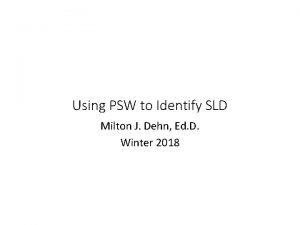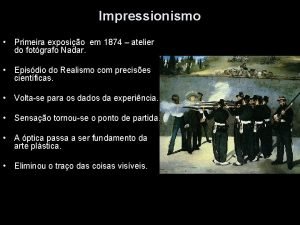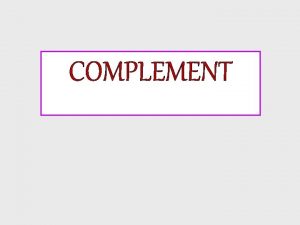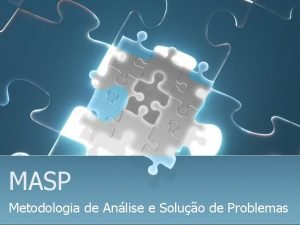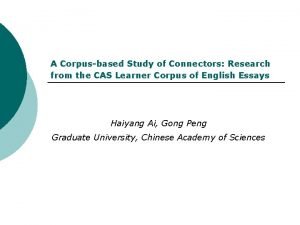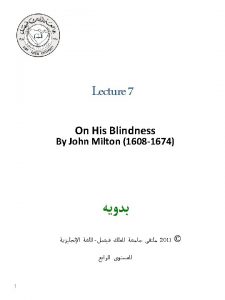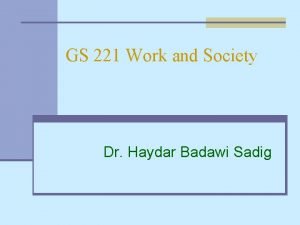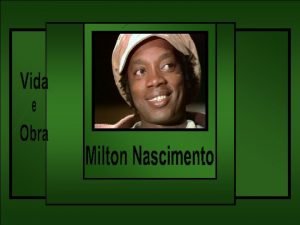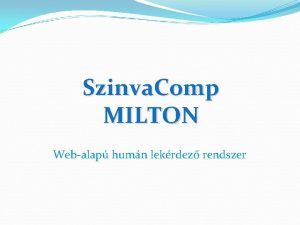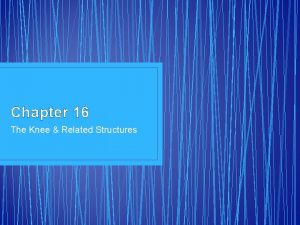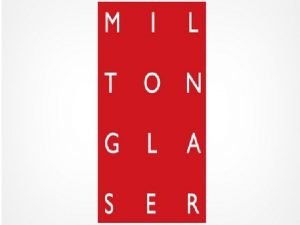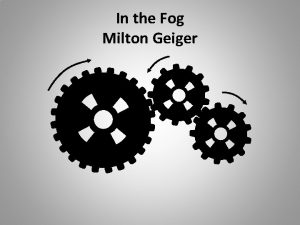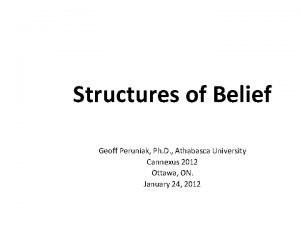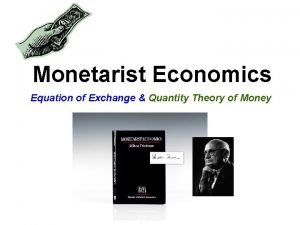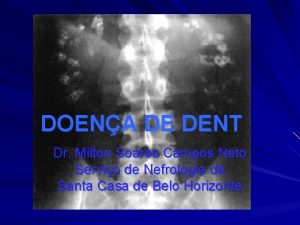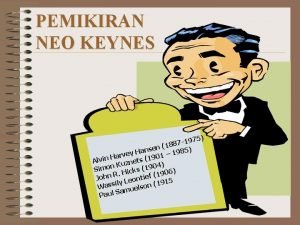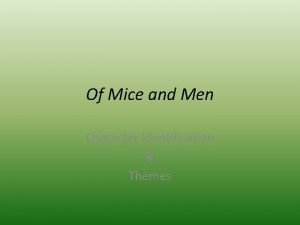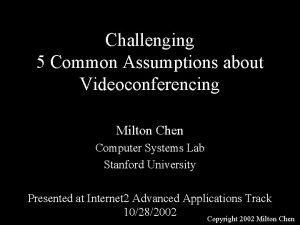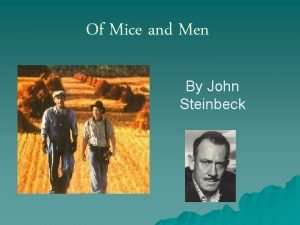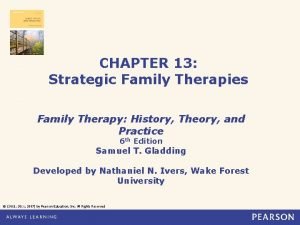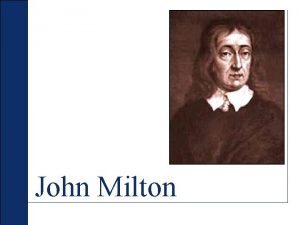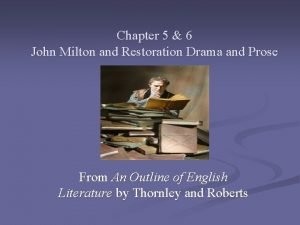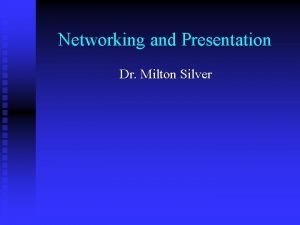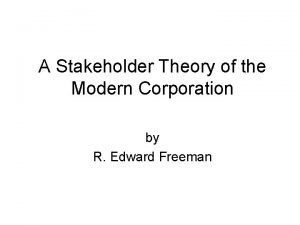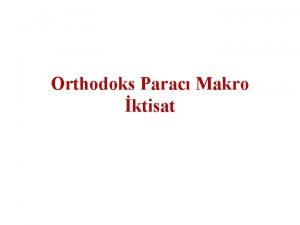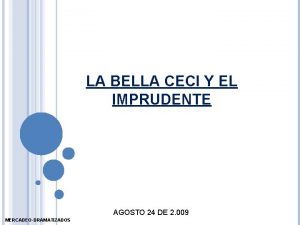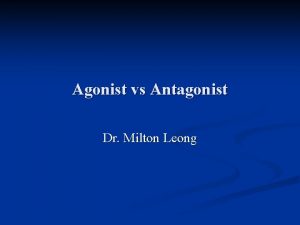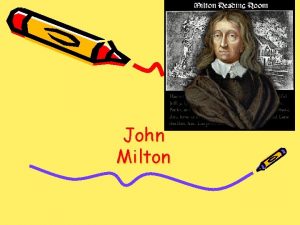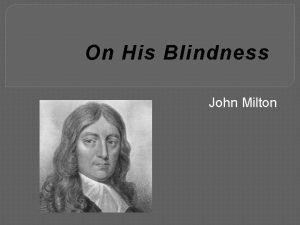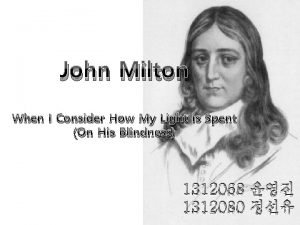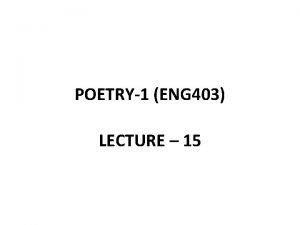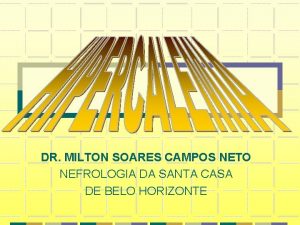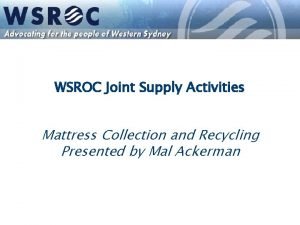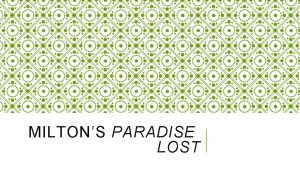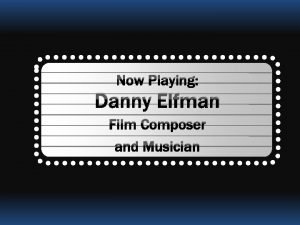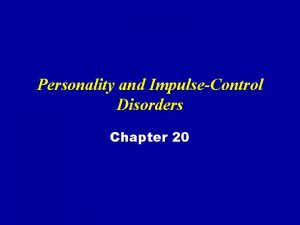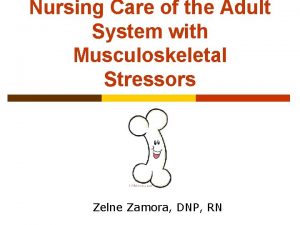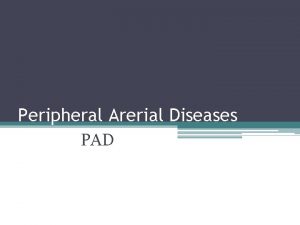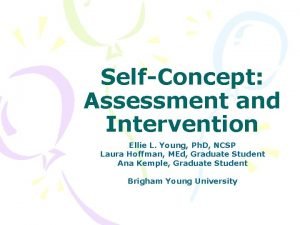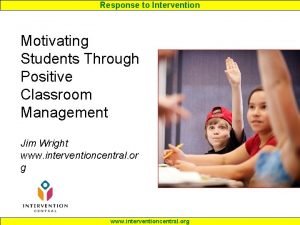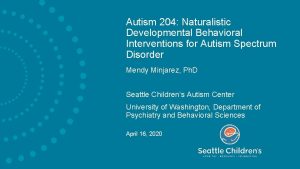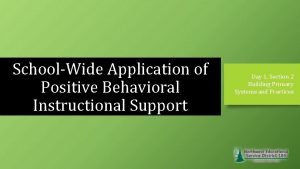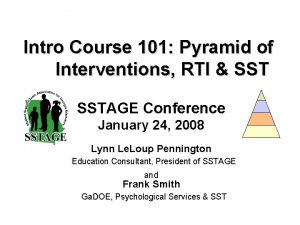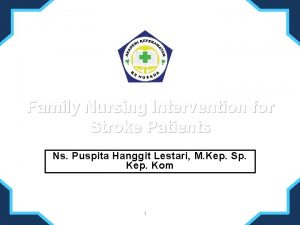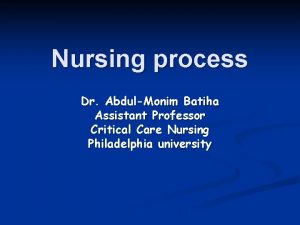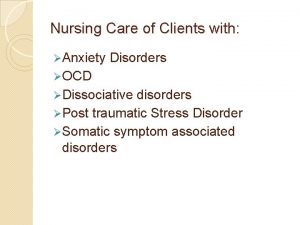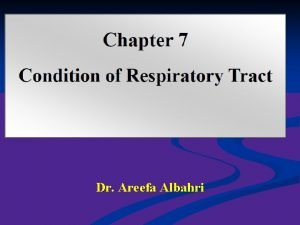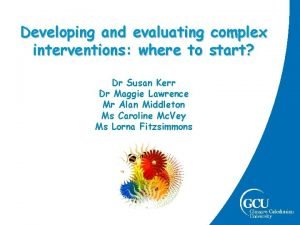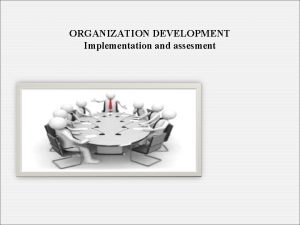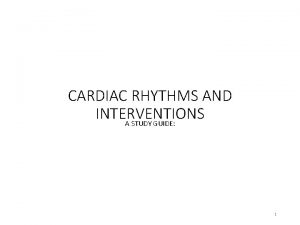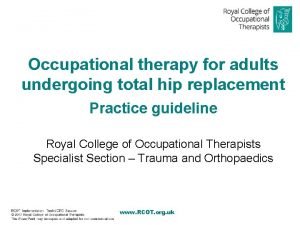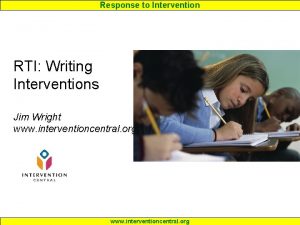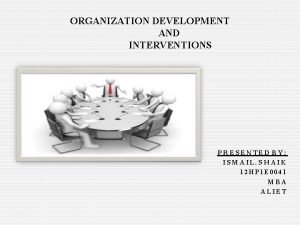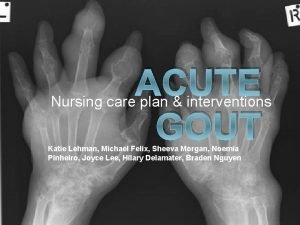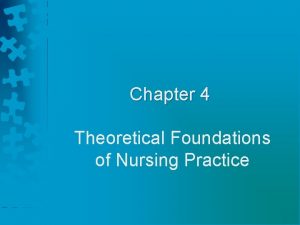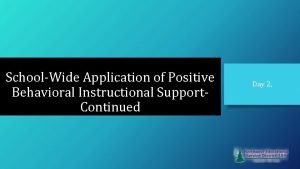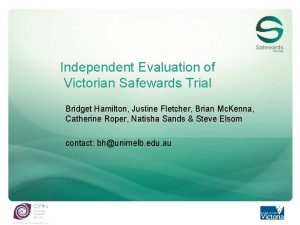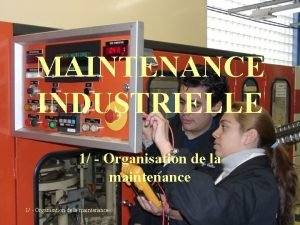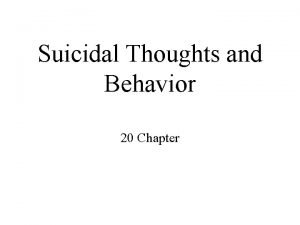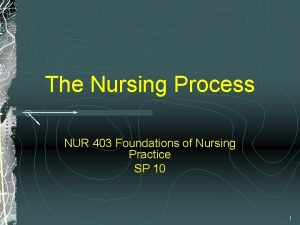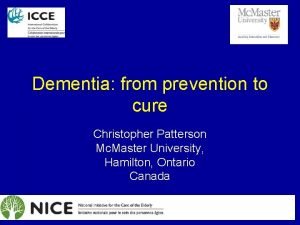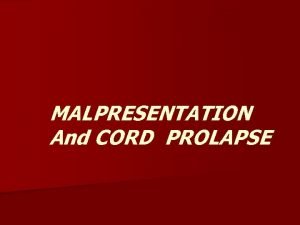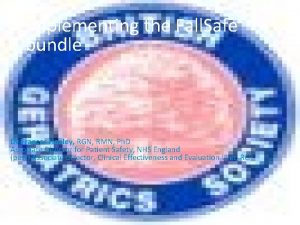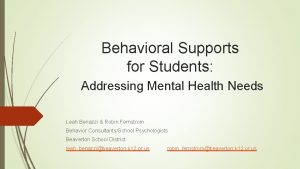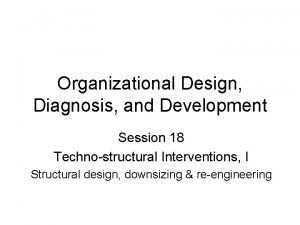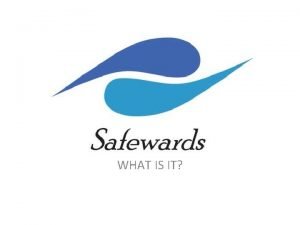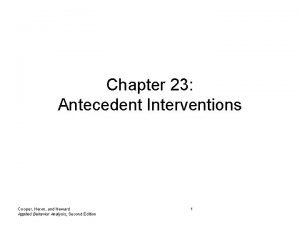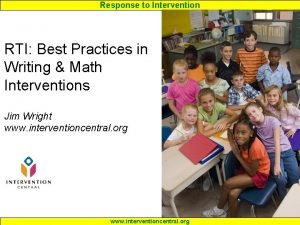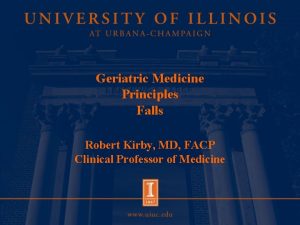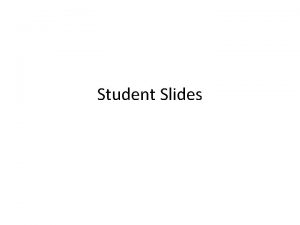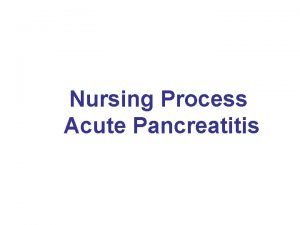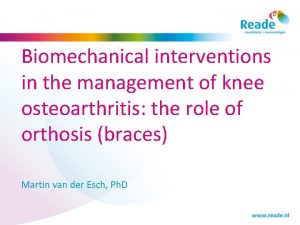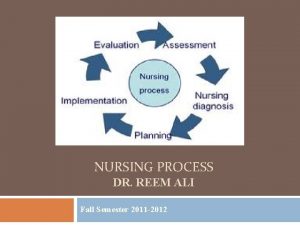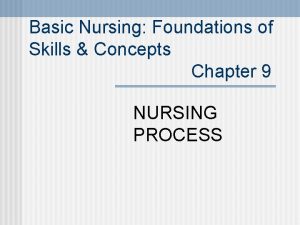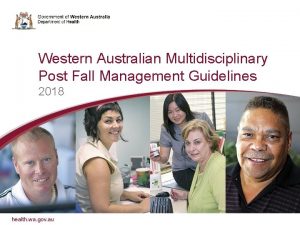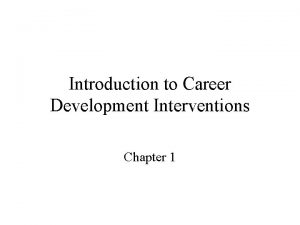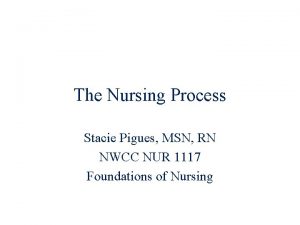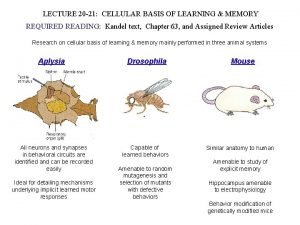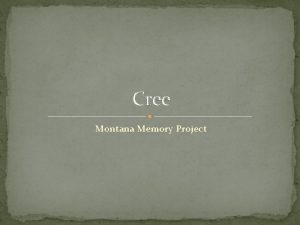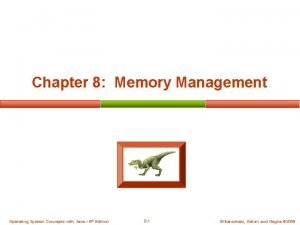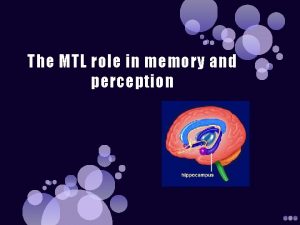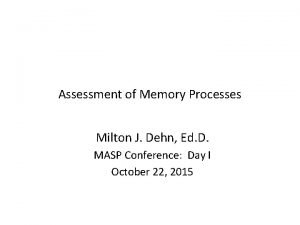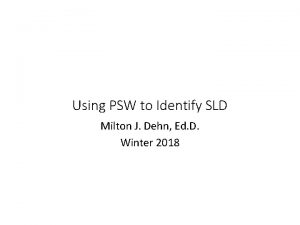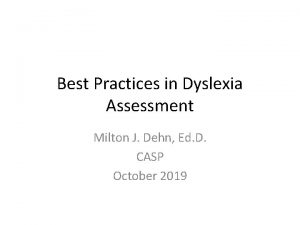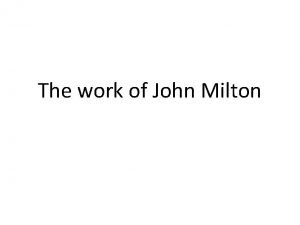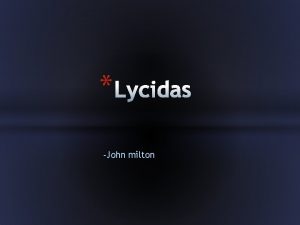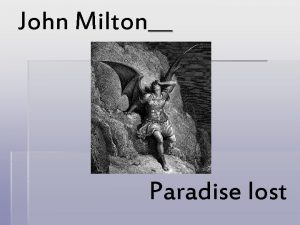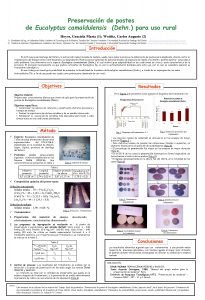Memory Interventions Milton J Dehn Ed D MASP




















































































































































- Slides: 148

Memory Interventions Milton J. Dehn, Ed. D. MASP Conference: Day II October 23, 2015

Notice of Copyright 2015 This Power. Point presentation and accompanying materials are copyrighted by Milton J. Dehn and Schoolhouse Educational Services, LLC. The Power. Point and materials are not to be reprinted, copied, presented, or electronically disseminated without written permission. To obtain permission, email milt@psychprocesses. com.

Workshop Information Sources 1. 2. 3. 4. 5. 6. 7. 8. Essentials of Working Memory Assessment Long-Term Memory Problems in Children Essentials of Processing Assessment, 2 nd Ed. Working Memory in the Classroom www. psychprocesses. com www. Schoolhouse. Educational. Services. com www. workingmemoryonline. com Presenter Contact: milt@psychprocesses. com

Workshop Content 1. 2. 3. 4. 5. 6. 7. 8. 9. Working Memory Exercises Cognitive Load Reduction Metamemory Working Memory Strategies Other Processing Interventions Working Memory Accommodations Long-Term Memory Strategies Mnemonic Classroom

Selecting/Planning the Intervention 1. Begin with assessment results 2. Deficits, intra-individual weaknesses, and normative weaknesses should be addressed 3. If no assessment, can do some matching from risk factors; see table 4. There are some core exercises and strategies that all should have 5. Do both WM and LTM; they support each other 6. Some trial and error necessary

To Select Methods, Consider: 1. 2. 3. 4. 5. 6. 7. Learner’s needs, goals, and priorities Related cognitive processing weaknesses The severity of the memory deficits How well the strategy generalizes The extent of practice required Learner’s age and overall cognitive ability Learner’s level of metamemory, executive functioning, and strategy use

Matching Memory Training to Specific Memory Deficits 1. Try to specifically address memory deficits 1. E. g. , if verbal WM is weak, then verbal WM training exercises and strategies are needed 2. If visual-spatial is average or above, minimal or no training is necessary in visual-spatial 3. See Table that matches needs and methods

Selecting Exercises and Strategies 1. If weak LTM, WM exercises should be included even if WM is normal 1. WM helps with encoding and retrieval 2. If weak WM, LTM strategies should be included even if LTM is normal 1. LTM reduces cognitive load and need to retain 3. Executive functions should be strengthened 4. Existing strategies might need re-training

How to Collect Data and Document Progress 1. Pre and post standardized testing (not the best) 2. HSR has non-standardized pre and post test 3. Rating scales before, during, and after, e. g. , CPPS 4. Track recall on material used with new strategies and compare with old/non-strategic learning 5. Monitor acad. performance, e. g. , homework 6. Assess attention/executive functions 7. Collect classroom test scores

Data Collection During Sessions 1. Collect immediate data each time a new strategy is introduced 2. Can be for WM or LTM (adjust intervals) 3. Student uses current method; measure recall 4. Introduce new strategy; measure recall 5. New strategy almost always works better 6. Improvement can’t be attributed to practice effects 7. Child immediately recognizes efficacy

Memory Interventions: General Approach 1. 2. 3. 4. Principle: make the brain work; it gets better Strengthen weakness/deficit with exercises Utilize existing strengths to compensate Use methods that involve other processes, more of the brain 5. Exercises prompt strategy use 6. Strategies allow more effective use of existing memory abilities 7. Accommodations and modifications that reduce the need to use the weak processes

Approaches to Strengthening WM 1. 2. 3. 4. 5. 6. Using LTM to support WM Reducing the learner’s cognitive load Using strategies to more effectively use WM Increasing WM capacity through exercises Providing accommodations and support Strengthening attention, executive functions, and related cognitive functions

Computerized and Internet-Based Working Memory Training 1. These are exercises, not strategies 1. But they prompt the use of a strategy 2. They work because of brain plasticity 3. Evidence that these exercises improve 1. With practice 2. Untrained WM performance (near transfer) 3. Far transfer to academics: evidence is inconsistent and limited

What is Required to Make a Computerized Exercise Work 1. Must be adaptive 1. Difficulty level constantly adjusted 2. Confirmed by research 2. Consistent high cognitive workloads 1. Has to be challenging enough 3. Extensive practice over a sustained period of time 1. 30 minutes a day for 25 days over 5 weeks min. 4. Processing and storage required during the task

Why WM Brain Training Works “the experience of taxing WM to its limits over a sustained period of time may induce long-term plasticity through either improving the efficiency of neuronal responses or extending the cortical map serving WM. The training program may also promote self-awareness and the development of compensatory strategies. ” Westerberg et al. , 2007).

Cogmed Training Details 1. Adaptive, game-like, internet-based training, records everything 2. Has preschool, school age, and adult levels 3. 25 sessions, 30 minutes each with 8 exercises out of 12, over 5 weeks 4. Child can do without assistance 5. Does not encourage use of strategies 6. https: //youtu. be/j-Pojkqekq 0 7. See Video

Research on Cogmed Training 1. 2. 3. 4. Improved WM, especially visual-spatial Fluid reasoning sometimes improves Math and reading sometimes improve ADHD kids improved in WM; less hyperactivity 5. Holmes et al. found substantial and sustained gains in WM and math

Cogmed Research Controversy 1. Two recent studies have concluded that the claims are “largely unsubstantiated” 2. No control group 3. Younger kids respond better 4. Not everyone improves 5. Is it just practice effects? 6. More recent study with proper design: WM improved, but still poor far transfer

Articles on Cogmed Controversy • Shipstead, Z, Hicks, K. L. , & Engle, R. W. (2012). Cogmed working memory training: Does the evidence support the claims? Journal of Applied Research in Memory and Cognition 1, 185 -193. • Melby-Lervag, M. , & Hulme, C. (2012). Is working memory training effective? A meta-analytic review. Developmental Psychology, DOI: 10. 1037/a 0028228 • Study with proper research design found WM gains: Gray et al. (2012). ). Effects of computerized working memory training program on working memory, attention, and academics in adolescents with severe LD and comorbid ADHD: A randomized controlled trial. Journal of Child Psychology and Psychiatry, 53, 1277 -1284.

Dehn’s Views on Cogmed 1. 2. 3. 4. 5. 6. Majority of kids will benefit Cost is an issue; timely feedback is an issue Maintaining practice schedule is concern Parents not trained to supervise practice In general, may be too superficial Cogmed discourages strategies; Dehn introduces when subject hits wall 7. Probably best for ADHD/WM co-morbid

Transfer and Maintenance 1. Most working memory exercises have good near transfer but poor far transfer 2. Why does it not far transfer and maintain, given learning’s dependence on WM? 1. Exercises are more STM than WM; don’t meet trainee’s WM needs 2. Not enough time allowed for transfer to occur 3. Lack of motivation and effort 4. Trainee does not do anything to maintain after training

Jungle Memory 1. 2. 3. 4. 5. 6. 7. Some evidence-based for working memory Improvements in WM and academics Includes letters, words, and math facts Only 3 exercises More appropriate for elementary than older 8 -week program A weaker program than Cogmed and most other online programs

WM Training Impact on Brain 1. Takeuchi et al. (2010) 2. Adaptive training with 2 N-Back visual tasks 3. Increase in white matter correlated with amount of training & improved performance 4. Mainly adjacent to the corpus callosum and in white matter parietal region 5. Increased transfer of info, at the dorsolateral prefrontal cortex, location of executive WM

The Most Powerful Exercise: N-Back 1. 2. 3. 4. 5. 6. Challenging task but easily administered Found to have corresponding growth in brain Remember stimulus n-items back n-back task Hands-on exercise covered later As a result of the research, most brain training programs have numerous n-back exercises

Lumosity 1. 2. 3. 4. 5. 6. Numerous exercises; based on research Some WM tasks under other categories Are adaptive and appropriate Affordable, annual membership Can monitor learner’s progress Select target areas when learner signs up or provide list of appropriate WM games 7. Lots of challenging n-back tasks 8. Difficult for young children; site says 13+ years

Brain HQ 1. 2. 3. 4. Affordable plans, such as yearly Variety of WM exercises but no N-back Some WM tasks under other categories Well designed, challenging, cover a wide range of ability and age 5. Has verbal WM exercises, e. g. , listening to a conversation

Guidelines for Selecting WM Apps 1. 2. 3. 4. 5. 6. Consistent high cognitive workloads Processing and storage required during task Program is adaptive; keeps records Extensive practice time Consistent with evidence-base; such as n-back More than visual-spatial; some kind of verbal processing and retention required 7. Encourages a conscious strategy

How To Use Online WM Exercises 1. These should be incorporated into intervention so that total exercise time is sufficient. 2. Can be done at home under parental guidance; set up a schedule with specific exercises 3. Can do some during your sessions under your account 4. Monitor their progress 5. Talk with child about using strategies and suggest strategies 6. Main concerns: does not follow schedule; no effort; just guessing

Discussion 1. What concerns do you have about online working memory training? 2. What benefits do you see in WM online training?

Cognitive Load Theory 1. WM is a combination of processing & storage 2. “Cognitive Load” is the processing portion 3. Processing & storage both draw on WM capacity; so it’s a balancing act 4. The greater the processing demands/longer the processing, the more info. lost from WM/STM 5. Can focus attention on only 1 aspect of WM at a time; switching is required 6. If focus on retention, processing may suffer 7. ADHD/WM impaired children become more hyperactive as cognitive load increases

Cognitive Load and Span Increasing cognitive load

Cognitive Load 1. Switching and amount of information increase the time to complete the processing 2. Environmental distractions add to cog. load 3. Irrelevant thoughts adds to cognitive load 4. Cognitive load is the main determinant of retention in WM (and STM) 5. In experiments with very high load, children can typically retain one item of information

Task Switching (Time Sharing) 1. Switching is a core, general executive process 2. To retain info. in WM, one must frequently switch from processing to refreshing the info. 3. If the processing (load) is demanding, there will be less switching and more info. will be lost 4. Theoretically, when cognitive load consumes all of WM; all info. is lost (Barrouillet, 2011) 5. Switching is difficult for young children 6. Example: remember steps while completing an online task

Cognitive Load in the Classroom 1. Three sources of cognitive load 1. The materials and their content 2. Instructional methods and teacher behaviors 3. The learner’s internal processing 2. Consult with teachers about this 1. Explain WM and cognitive load 2. Talk about supporting student by reducing cognitive load See Handout

Cognitive Load in the Classroom 1. Instruction easily overloads WM 1. By the nature of the material 2. By the manner it is presented 2. Focus on designing curriculum and instruction that reduces cognitive load 1. Direct Instruction example

WM Classroom Overload Examples 1. 2. 3. 4. 5. 6. 7. 8. Long, complex, inconsistent verbalization Requiring two processes simultaneously No time for processing or rehearsal No external memory aids Noisy learning environment No or limited scaffolding (learning supports) Disorganized presentations Too many concurrent demands

More Overload Examples 1. 2. 3. 4. 5. 6. Excessive length Unfamiliar and not meaningful content Demanding mental activities Need to integrate information Keeping track of steps while doing task Tasks that require a lot of switching of attention

Reducing Cognitive Load 1. See handout 2. Well designed instruction reduces load 3. Or, allow processing without need to remember; e. g. facts in writing are available 4. Or, processing reminders are available 5. Teach students to alternate between processing and refreshing 6. Students learn under low load conditions

Reducing Cognitive Load 1. 2. 3. 4. 5. 6. 7. Only one step, process at a time Allow time for processing and rehearsal Allow self-paced processing Provide external memory aids Quite learning environment Organized materials and presentations Worked, partially-completed examples 1. Keep adding more for student to complete

Reducing Cognitive Load 1. 2. 3. 4. Sequence material from simple to complex Present material in an integrated way Include visual presentation Side by side information (being able to see as all the information in an integrated fashion) better than stacked information 5. Avoid load that is not related or necessary to the learning (extraneous load)

WM and Automaticity 1. Mastery or fluency reduces cognitive load 2. Reading decoding & reading comprehension 3. Math problem solving better with fluency 4. Written language better with fluency 5. Automaticity equals faster processing and ability to focus on higher level of processing instead of basic skills 6. LTM prior knowledge, expertise, and mastery support automaticity

Reducing Cognitive Load at Home 1. You can also apply some of the classroom recommendations 2. Could cognitive overload be causing some assignment completion problems at home? How?

Skills to Teach Students for Reducing Cognitive Load 1. 2. 3. 4. 5. 6. Ask for help and repetition Take notes; use post its Be organized Don’t self-overload; one task/step at a time Learn to use memory aids How to switch between processing and rehearsal (WM exercises good for teaching this strategy)

Cognitive Load Discussion 1. How do you recognize in yourself when you are experiencing cognitive overload? 2. What are signs of cognitive overload in a child? 3. Why/how does cognitive overload reduce learning and impair performance? 4. What is an effective executive WM strategy of trying to cope with high cognitive load?

Metamemory Overview 1. Teach child how memory works and its limitations 2. Inform child of personal strengths and weaknesses 3. Teach child self-awareness 4. Teach about how we can control memory Video I

Why is Metamemory Training Essential? 1. Without it, there is: 1. Less motivation and cooperation 2. Continued misconceptions and frustration 3. Less maintenance and generalization

More on Metamemory 1. This is ongoing through sessions 2. Always help child understand why, when, where it works or will benefit (conditional knowledge) 3. Always show the child the data 4. Reinforce progress 5. Child should become expert on memory 6. The older the child, the more metamemory

Demonstrating Efficacy of Interventions 1. Differs by age level 2. Lower Level: Memorize word list versus memorize list while visualizing the object 3. Upper Level: Organizational strategy 1. Memorize random words 2. Memorize words arranged in categories 3. Dramatic improvement is convincing 4. Important for maintenance I II 5. How else can you document efficacy for trainee?

Discussion • Give examples of weak metamemory that you have observed. • How might poor metamemory lead to ineffective memorization attempts?

WM Strategies: Rehearsal 1. 2. 3. 4. 5. This is the most fundamental strategy It is necessary for both WM and LTM Keeps active in WM; allows more LTM encoding Most have by age 10; 1 st graders can learn Students with severe memory problems can not maintain sequence during verbal rehearsal 6. Academic benefits if taught classroom wide 7. Rehearsal can also be an exercise

WM Rehearsal Strategies (also for LTM) 1. Goal: Maintain until WM done or encoded 2. Serial and cumulative repetitive process 3. First aloud, then subvocal 4. Increase length of list as student improves 5. Good maintenance of strategy if overlearned

Rehearsal (Strategy) Training Steps 1. Serial: present all items at once 2. Cumulative: Repeat first word until next delivered then add next word to the repetition 3. First aloud, then whisper, then subvocal, then check to see if student using 4. Student needs to learn when to use this 5. Practice training student to do cumulative

Using Rehearsal with Switching 1. Switching back and forth between the processing and rehearsal 2. Switching with rehearsal helps maintain the information in STM while processing the same or other information 3. Require trainee to use rehearsal with switching for most WM exercises 4. Switching is embedded in all WM exercises

Rehearsal as an Exercise 1. 2. 3. 4. Goal is to build span and maintain sequence Other goal: Some oral-to-oral WM practice Have student repeat sequence 4 -5 times Listen to see if student maintains correct sequence; “answer” is not necessary 5. Have the student say the words faster 6. Can be serial or cumulative

Material for Rehearsal Exercises 1. 2. 3. 4. Use a variety of stimuli Letters phonemes, numbers, words Non-words are ideal Require aloud rehearsal when child can not maintain sequence

Chunking Strategy 1. 2. 3. 4. 5. 6. 7. Chunk items to be remembered as a whole Combining numbers, letters, or words Spelling: letters in syllable become a chunk Chunks become patterns in LTM Make list longer as training proceeds Continue until chunking is automatic Chunks expand WM capacity

Criteria for Face-to-Face WM Exercises 1. 2. 3. 4. 5. 6. 7. Same as for online WM exercises Is adaptive Clearly requires WM Consistently places high demands on WM Practice on a regular, ongoing basis Some of these tasks used to measure WM If meets these criteria, should improve WM

Face-to-Face WM Exercises 1. Compliance with online training is a concern 2. Oral responding not allowed with online training 3. A trainer, parent, or peer administers these; some can be self-administered 4. With all exercises, require a longer span as progress is made

Using Math to Build WM • Complete calculations • Remember the answers in sequence 4+3=7 9– 3=6 8 + 2 = 10 Response: 7, 6 • With groups, call on one student randomly for response • Practice

Using Math Flashcards to Build WM 1. Practice for everyone 2. Trainee must use cumulative rehearsal 3. Best to use more than one operation in same deck 4. How should calculation errors be handled?

N-Back Task (Exec. WM) 1. 2. 3. 4. 5. 6. 7. 8. Found to have corresponding growth in brain Challenging task but easily administered Remember stimulus n-items back Do it repetitively Deck of cards ideal; prevents practice effects Parents and children can practice at home n-back task What strategy would you teach the child for succeeding at this? 9. Improvement will be slow at this task 10. See Training Manual p. 43; HSR Lesson 20

N-Back Procedures Summary 1. Display items one at a time for 1 -2 seconds 2. Start over after 1 st error 3. Should get 10 consecutive correct 3 times before going to next N 4. 5 – 10 minutes, 4 times per week 5. More challenging: A double n-back 6. Establish baseline 7. Encourage strategy use 8. What other materials can be used? 9. Two-way practice for all; verbalize strategy

Counting Span 1. 2. 3. 4. Make up cards with random number of dots Dots of a different color are distractors Count the number of items on each card Remember the total on each card in correct sequence

Last Word 1. Found to have a high correlation with reading comprehension 2. Not used as a training exercise in research 3. Must remember the last words in each of a series of sentences. 4. Must answer a question about each; this is the processing part

WM Exercises for Young Children 1. 2. Use age-appropriate stimuli to practice rehearsal For visual-spatial sequences, use letters on cards, numbers on cards, pictures of objects, or actual objects. 3. Steps: 1. Present each item for two seconds, then hide it 2. After all items are presented, child says items in sequence 3. Teach the child to use rehearsal to maintain the sequence 4. Also use objects without requiring rehearsal. For example, present 5 small toys for 10 seconds. Then remove them and place them with a larger group of toys. Then ask the child to point the ones that were displayed previously. For a strategy, teach the child to name each target toy/object when they are displayed.

Exercises by Age Young Child (8 & under) • More Simple Span • Rehearsal • Counting Span • Memory for Objects (not in sequence) • Math flashcards • Pointing as Directed • Visual-Spatial Grid • • Older Individual More Complex Span Rehearsal Last Word Pointing as Directed N-Back Math Flashcards Pointing as Directed

Discussion • Which of the WM face-to-face exercises seem easy to administer? • Which of the WM face-to-face exercises do you believe would be the most beneficial?

Other Cognitive Processing Interventions that Support WM 1. 2. 3. 4. 5. 6. Attention Executive functions, such as planning Oral Language Phonological Processing speed Fluid reasoning

Attention: Self-Monitoring 1. Teacher, or device carried by student, cues student at variable intervals, such as 5 minutes 2. Ratings: 2 -Completely on task; 1 -Partially on task; 0 -Completely off task 3. Teacher can also provide rating alongside student’s; student receives bonus point when ratings match 4. Set a points goal that student is working for, easy at first, then keep adjusting upward 5. Two options; entire interval is best

Executive Functions 1. See Mc. Closkey for other EF interventions 2. Developing planning improves math performance 3. Discuss benefits of plans 4. Develop plans 5. Verbalize them 6. Implement them and evaluate

Fluid Reasoning 1. 2. 3. 4. Problem solving Categorizing Similarities and differences Games that require reasoning and recognizing relationships

Oral Language 1. Closure procedures 2. Categorizing words 3. Create a variety of sentences using same words 4. Synonyms and antonyms 5. Paraphrasing 6. Language therapy

Phonological Processing 1. Phonemic awareness interventions very effective. 86 effect size (the earlier the better) 2. Oral at first, then with written material 3. Rhyming; isolating phonemes; identifying phonemes; deleting phonemes; categorizing common phonemes; segmenting phonemes that comprise words; and blending phonemes into words

Processing Speed • Video Games

WM Accommodations 1. 2. 3. 4. 5. 6. 7. 8. Extended testing time Repeating information in a simplified manner Providing written checklists and reminders of step-by-step procedures One task at a time Slow down presentation Preferential seating to reduce distraction Provide prompts and cues

Written Language and WM 1. Signs of WM overload during written expression: omitting words, repeating words, forgetting what was going to say, can‘t start 2. Extreme: can’t get ideas into words on paper 3. Writing requires lots of executive WM; lots of switching, updating, and inhibition

Written Language Modifications 1. Have the student express it orally first 2. Teacher “stores” it and says what student said as student writes 3. Or, teacher writes part of sentence so that student just needs to use closure to finish 4. Teach learner to switch back and forth between rehearsal and writing

More Written Language Mods. 1. Shorten writing assignment 2. Allow shorter sentences 3. Allow opportunity to revise after feedback provided 4. Allow abbreviations and symbols in first draft 5. Provide notes, note-taker, or partially completed class notes in classes where notetaking is required

WM and Math 1. Math demands a lot of both WM and LTM 2. Signs of WM overload during math: finger counting; computation errors when facts known; ignoring the signs; can’t do it mentally; confused by story problems 3. Visual-Spatial WM exercises will help math performance improve

Mathematics Modifications 1. Lighten the load by allowing written step-bystep procedures 2. Help to identify story problem words that indicate the math procedures involved 3. Allow access to arithmetic fact tables 4. No timed math tests 5. Allow calculators

WM and Basic Reading Skills 1. Support student during decoding & blending 2. Prompt by saying first phoneme or syllable 3. Say the segmented phonemes/syllables slowly after student has sounded them out 4. Have student say blended word smoothly again after correct pronunciation 5. Rehearsal and chunking training should be beneficial; especially rehearse nonwords

WM and Reading Comprehension 1. Student previews and skims the passage to activate relevant prior knowledge so that long-term memory supports WM 2. If substituted word is consistent with meaning, do not interrupt to correct 3. Have student pause after each sentence and paragraph to reflect on its meaning 4. Test comprehension, not long-term memory by asking questions after each paragraph

WM and Taking Notes 1. Reduce quantity by teacher-supplied partial notes 2. Have a note-taker 3. Student learns to use some shorthand, symbols, and abbreviations

WM and Automaticity 1. Automaticity, mastery, and fluency reduce cognitive load 1. Reading decoding and reading comprehension 2. Math problem solving 3. Written language 1. Organization and coordination 4. Long-term memory structures free up WM 5. Automaticity equals faster processing

Consultation Practice 1. Pick a WM strategy, exercise, or accommodation. 2. How would you go about convincing a classroom teacher to try teaching or using it? 3. How would you teach the teacher to use it?

LTM Intervention Approaches 1. Working memory (enhances LTM encoding) 2. Executive functions; metamemory 3. Strategies and mnemonics to make better use of existing abilities 4. There are no LTM exercises 5. Memory aids and accommodations 6. Effective instruction, such as DI 7. Health and physical variables

Strong WM Supports Encoding and Retrieval 1. Reducing the “cognitive load” on the learner’s WM allows more encoding 2. A stronger WM can handle the cognitive load introduced by LTM strategies 3. Thus, students with deficient LTM but normal WM should also receive WM exercises and strategies

LTM Interventions 1. 2. 3. 4. 5. 6. These are evidence-based; brain-based One-on-one, small group, classroom wide Includes direct and consultation/training Through trained parents/teachers sometimes Kindergarten through adulthood Some tied with academic skills & study skills

Concerns About LT Memory Interventions 1. Some strategies don’t generalize well 1. Specific to task and content 2. With multiple steps, learning a strategy can overload WM 3. Increased metamemory is necessary 4. Far transfer to academics; less of a problem than with WM training

Weak LTM Strategies 1. Not all educational practices are actually effective, 2. Acronyms such as HOMES 3. Cramming 4. Review 5. Rehearsal

Support for LTM Interventions 1. Consistent with neuroanatomy 2. Consistent with what is known about memory processes 3. Have a theoretical basis 4. Have supporting research

LTM General Principles 1. Based on neuropsychology and research 2. See link 3. Select two principles that are so important that they should be applied with all learners, even those without and LTM deficit. Why are these two principles so important?

Dehn’s Big Six LTM Intervention Principles 1. 2. 3. 4. 5. 6. Deeper processing; e. g. elaboration Visualization; e. g. dual encoding Organization; e. g. , semantic clustering Associations, linking; e. g. , mnemonics Review and retrieve; e. g. , testing effect Metamemory

Selecting LTM Interventions 1. Identify strengths and weaknesses 1. Visual vs verbal 2. Episodic vs semantic 2. Is there a process weakness: encoding, consolidation, storage, retrieval 3. Consider “cause” risk factor 4. Trial and error: use data to figure out what works

To Select Methods, Also Consider 1. 2. 3. 4. 5. 6. 7. Learner’s needs, goals, and priorities Related cognitive processing weaknesses The severity of the memory deficits How well the strategy generalizes The extent of practice required Learner’s age and overall cognitive ability Learner’s level of metamemory, executive functioning, and strategy use

Dual Encoding 1. Instructors should make it both verbal and visual or give students time to recode 2. Can be done independently as well 3. Instruct students to visualize verbal info. 4. Instruct students to name/describe visual 5. Why does it work?

Visualization 1. The process of visualizing verbal information 2. For young children, teacher/trainer may provide picture of or describe an image 3. Others should visualize and then describe 4. Retrieved as a visual-spatial item; leads to recall of verbal information 5. For best results create effective visual images 6. Practice visualizing word list

Linking 1. Linking two items to be remembered together in an image is effective 2. But linking while using the structure of mnemonic is more effective because the items are then associated with something you won’t forget 3. Practice linking word list 4. Verbal linking is okay; but it is better with an image

Visual Images That Are Effective 1. Should be linked/interactive, not just imagined side-by-side 2. Funny, weird, etc. 3. Personal 4. Focused 5. Created by user

Visualizing and Reading Comprehension 1. Direct student to visualize while reading 2. Should pause frequently and deliberately create imagery if this does not happen automatically 3. Have student describe the images (different than verbally retelling the story)

Reading: Imagining Self in Scene 1. Imagining yourself in the scene, viewing things as if you were actually there 1. Imagine details and feelings 2. For literature, social studies 2. Why does it work?

Organization 1. Organize information in a manner that makes sense to self 2. Good for both WM and LTM 3. Examples: a timeline, by subject, category, etc. 4. Why does it work?

Semantic Clustering 1. 2. 3. 4. Group items by category Objects or words Clusters become chunks in memory Have student focus on memorizing the name of the clusters 5. When item recall fails, recall cluster and think of items in that category until recognized

Visual Mnemonics 1. History of Mnemonics 2. Different from visualizing 3. Link information to something already known that will not be forgotten 4. Acts as a scaffold or bridge 5. Involves pairing images that convey meaning 6. Why do they work?

Loci (The Palace Technique) 1. 2. 3. 4. 5. 6. Romans matched items with a route Evolved into the Palace method How the competitors use this approach https: //youtu. be/PIg 73 ppo. VZw See video (Andi Bell on youtube) Same locations can be used again with different items 7. Pick or create your palace; can have more than one

Loci with Children 1. With children, use items in their bedroom 2. Or rooms in their house 3. Use items/rooms in sequence so nothing is forgotten 4. Have them follow visualization rules 5. Suggest associations as needed

Loci Practice A mythical nation exports these products: – Gold – Horses – Cotton – Diamonds – Lumber – Snakes – Computers

Keyword 1. 2. 3. 4. 5. 6. Highly effective; effect size of 1. 6 Combines auditory and visual First, the acoustical link (keyword) Then, image of linked items interacting To retrieve, think of keyword first LD do better when keyword & image provided

Keyword Practice 1. Video illustrates a “double” keyword 2. Use keywords for Denver, Colorado 3. Single Keyword practice with Spanish vocab: 1. Vaca = cow 2. Carta = letter 3. Escalera = ladder 4. Make the images unique, interactive, but focused on the keyword and meaning

Elaboration 1. Elaboration is explicit, conscious linking of prior knowledge with new information 1. “Fire together, wire together” principle 2. Also, deeper processing 2. Strengthens encoding, organization, consolidation, retrieval 3. Teachers should provide for young child but can be done independently by older students

Elaboration 1. Give a teacher an example of how to use elaboration when teaching about a new country in Africa

Elaboration: Why Question • With self application, answering the why question is most effective • Student asks and answers: – “Why does this make sense” or – “Why is this true”

Elaboration and Reading Comprehension 1. Student previews and skims the passage 2. Student thinks about what he/she knows about the topic 3. Student pauses after each paragraph, identifies the most important information 4. Students asks and answers the “why” question about that important piece 5. An alternative is KWL

Periodic Review with Expanding Interval 1. Reviewing strengthens memories, but can also change them 2. For tests, at least 3 reviews are recommended and not on the same day 3. Cover up answers and force retrieval 4. Do not guess wildly when reviewing (error learning) 5. Expanding interval works best 1. Because it’s better if it takes effort to recall

Expanding Interval Review 1. 2. 3. 4. 5. 6. More efficient than massed/daily review Strengthens neural pathways Increases learning by 15% Builds on remembered information Supports consolidation & semantic memory Information must actually be retrieved; best when effortful retrieval needed 7. Review should be about the time information is beginning to decay 1. E. g. , 1, 2, 4 days, 1, 2, 4 week intervals

The Retrieval Principle 1. Retrieve from LTM, not STM 2. More effective than just reviewing 3. More effective when info is partially forgotten and it takes effort to retrieve 4. Also strengthens recall for related info. 5. Supports consolidation and reconsolidation 6. Why does it work? 7. Explain to an adolescent how to apply this principle

Periodic Testing 1. 2. 3. 4. 5. 6. 7. Extremely effective First quiz immediately or within a day Expanding intervals like periodic review Not limited to items actually tested Can be self-testing Why does it work? Can be self-testing

Six-Year Old Case Study Concerns 1. 2. 3. 4. 5. 6. 7. 8. Learning colors, letters, and numbers Inconsistent performance Recognizing and generating rhyming words Difficulty learning to read Doesn’t remember directions Difficulty getting started on a task Word retrieval problems Math learning difficulties

Six-Year Old Case Risk Factors 1. 2. 3. 4. 5. Blood clot in umbilical cord Abusive father; stressful home environment ADHD Speech/language delay and disorder Seizures (left frontal lobe)

Six-Year Old Case Diagnoses 1. 2. 3. 4. 5. ADHD Language Disorder, with word retrieval probs. LD Seizure Disorder Placed under OHI

Six-Year Old Previous Interventions 1. 2. 3. 4. RTI Math: Failed to respond adequately Tutoring at home by grandmother Earobics Phonemic awareness training

Six-Year Old Assessment Results 1. 2. 3. 4. 5. Full Scale IQ of 95 Executive dysfunctions Weak STM, especially visuospatial Working memory borderline low average Weak long-term memory 1. Encoding 2. Consolidation 3. Retrieval (Severe word retrieval problems)

Six-Year Old Case Interventions 1. Prioritize memory components/processes for intervention. Pick top three 2. Pick six exercises/strategies that you would begin with 3. Why would you pick these six?

Severe Memory Impairments 1. Less cognitive load 2. Rely primarily on verbal or visual-spatial with recoding 3. Longer, more intense training 4. More practice with strategies 5. Modified exercises and strategies 6. More support, e. g. prompts 7. Deliver information “just in time” 8. Reduce error learning 9. Reduce interference 10. Recognition testing

Severe Memory Impairments 1. 2. 3. 4. 5. 6. 7. Avoid WM overload when training Tie more directly to academic and daily skills More daily life memory functions Limit number of strategies Mnemonics may be less effective Train parent to support Aides, accommodations, technology

External Memory Aides 1. 2. 3. 4. 5. 6. 7. 8. 9. Diaries or journals Memory books or memory notebooks Alarms and timers Reminders provided by computers Schedules and assignment calendars Checklists with step-by-step procedures Folders for organizing notes and materials Lists of activities that need to be completed Step-by-step instructions for using a strategy

Digital Memory Book 1. Contains important information that is difficult to remember or needed on a daily basis 2. Schedule (for everything) 3. Procedures for completing tasks 4. Procedures for memory methods 5. Contact information 6. Photos 7. Personalize and continue to add to

Reducing Interference 1. 2. 3. 4. 5. 6. Avoid similarity and too much info at once Switch topics Take breaks Take naps Study before sleep Quiet environment

Reducing the Learning of Errors 1. 2. 3. 4. Reduce learning of errors Unlearning of errors is difficult Especially for severe amnesic cases Prevent guessing; supply most of the answer

Procedural (Implicit) Learning 1. Cases of amnesia, partial amnesia, severe LTM impairments can learn and remember procedures better than explicit memories 2. Won’t remember learning it or that they know it but can perform when prompted to do so 3. Thus, do more procedural training 4. Example: Case with lead poisoning

Context Cues 1. Within the first week or so, retrieval of info is from episodic memory, not semantic 2. Episodic cues facilitate recall: smell, objects, colors, feelings, etc. 3. Testing in an environment other than the actual learning environment lowers test scores by as much as 30% 4. Teach students to recall the environment when they are tested elsewhere

Accommodations for Testing 1. Inform student of exam dates well in advance to allow for periodic review 2. Provide review sheets in same format as tests 3. Provide notes of lectures 4. Allow students procedural checklists 5. Recognition testing: word banks, etc. 6. Extended time on testing; notes during test

Improving Recall During Tests 1. 2. 3. 4. 5. Testing accommodations Context cues Elaboration Take time Recognition

Health Supports for Memory 1. 2. 3. 4. 5. 6. 7. 8. Reduce risk of concussion Control seizures Treat disorders; medication for depression No illicit drugs Maintain steady glucose level Exercise Reduce stress and anxiety Interference breaks

Diet and Glucose Levels 1. Hippocampus functions best when there average to moderately high levels of glucose 2. It is important during both encoding and retrieval

Sleep Benefits 1. Sleep deprivation harms recall 2. Naps enhance recall 3. Study, review, practice just before sleep leads to better recall 1. Retroactive interference eliminated 2. Material ready for consolidation

Benefits of Exercise 1. Many studies document the benefits of aerobic exercise for maintaining and improving long-term memory in adults 2. Only a couple of studies with children 3. However, children have the same LTM brain structures. Thus, adult benefits should apply to teens and children.

Medications 1. Methylphenidate improves ability to focus and WM performance 2. For LTM in adults with MCI or Alzheimer’s medication reduces/slows memory loss 3. These medications may help undiagnosed adults 4. Cholinesterase inhibitor 5. Memantine or Namenda

The Mnemonic Classroom 1. Is a memory-focused classroom 2. Focus on instructional methods that support all memory processes 3. Teacher has memory expertise; understands how LTM functions 4. Educates students about memory 5. Teaches memory strategies/mnemonics 6. Conveys message that you can improve your memory

The Mnemonic Classroom 1. Teacher uses instructional methods that support long-term memory 2. Is aware of what the hippocampus needs 3. Provides interference breaks 4. Reminds students to be memory-focused 5. Knows LTM General Principles 6. Mnemonic instruction improves academic learning

Teacher or Student Strategies in Mnemonic Classroom 1. 2. 3. 4. 5. 6. 7. Repetition Dual encoding, mainly visualizing Elaboration Expanding interval review Testing/Self-Testing Context cues Reducing interference

The Mnemonic Classroom: Examples of Metamemory Instruction 1. There are different types of memory: short-term and long-term; visual and auditory; and personal and academic. 2. Simply desiring to remember something does not make it more memorable; it takes effort, some kind of strategy 3. Using effective memory strategies actually save study time in the long run. 4. Remembering is easier when the information being studied is organized. 5. Remembering is easier when information is encoded both visually and verbally.

How to Encourage Teachers to Be Mnemonic Based 1. What approach would you use to get the classroom teacher to “buy in”? 2. How might you facilitate and support implementation in the classroom?

College Case Study 1. 2. 3. 4. 5. 6. 7. Cancerous brain tumors at age 16 Affected vision and memory Originally an A-B student, now failing Both episodic memory & semantic probs. Prospective memory problems Metamemory not realistic Working memory okay

College Case Strategies 1. 2. 3. 4. 5. 6. 7. Preview text, elaborate with “why” question Metamemory and interference breaks Self-made review sheet Periodic review schedule Self-testing (retrieval) Testing strategies to enhance retrieval Memory book

College Case Outcomes 1. 2. 3. 4. 5. 6. 7. 8. Started on academic probation 2. 5 at end of first semester with intervention 3. 5 at end of two-year college program Student gained confidence Continued residing with parents See his plan on pages 75 -79 Another college student High school student feedback (see Hannah)

Memory Training for Individuals For working memory and long-term memory Parent consultation and training available www. Schoolhouse. Educational. Services. com milt@psychprocesses. com 608 -781 -0532

Memory Interventionist Training • • • For psychologists and related professionals Background in psychoeducational assessment required Taught by Dr. Dehn Taught once per year, beginning in fall CEU’s from Kids, Inc. 36 -hour course Includes neuropsych assessment of memory Case study with supervision Details: email milt@psychprocesses. com www. Schoolhouse. Educational. Services. com
 Psychological processing analyzer
Psychological processing analyzer Degas masp
Degas masp Masp-2
Masp-2 Masp
Masp Dehnport maxi
Dehnport maxi Virtual memory and cache memory
Virtual memory and cache memory Spreading activation psychology
Spreading activation psychology Primary memory and secondary memory
Primary memory and secondary memory Virtual memory in memory hierarchy consists of
Virtual memory in memory hierarchy consists of Implicit and explicit memory
Implicit and explicit memory Logical versus physical address space
Logical versus physical address space Shared memory vs distributed memory
Shared memory vs distributed memory Eidetic memory vs iconic memory
Eidetic memory vs iconic memory Long term memory vs short term memory
Long term memory vs short term memory Which memory is the actual working memory?
Which memory is the actual working memory? Internal memory and external memory
Internal memory and external memory Milton altenberg
Milton altenberg Milton catelin
Milton catelin On his blindness by john milton
On his blindness by john milton Dr badawi milton
Dr badawi milton Milton nascimento apelido
Milton nascimento apelido Milton web
Milton web Invocation paradise lost
Invocation paradise lost Makenzie milton injury
Makenzie milton injury Milton glaser born
Milton glaser born In the fog milton geiger
In the fog milton geiger Milton rokeach
Milton rokeach On the late massacre in piemont
On the late massacre in piemont M.v=p.y
M.v=p.y Cubilina
Cubilina Summary of paradise lost by john milton
Summary of paradise lost by john milton Paradise lost date
Paradise lost date Teori milton friedman
Teori milton friedman Candy personality of mice and men
Candy personality of mice and men Milton l olive middle school
Milton l olive middle school Milton chen
Milton chen Plastic things that can be recycled
Plastic things that can be recycled Of mice and men george
Of mice and men george Milton erickson
Milton erickson Dr john milton
Dr john milton Paradise lost iambic pentameter
Paradise lost iambic pentameter Restoration prose
Restoration prose Dr badawi milton
Dr badawi milton What is monetarism
What is monetarism H milton stewart
H milton stewart Dr ruth milton
Dr ruth milton Friedman vs freeman corporate social responsibility
Friedman vs freeman corporate social responsibility Of man's first disobedience poem by john milton
Of man's first disobedience poem by john milton Milton keynes population 2021
Milton keynes population 2021 Milton friedman teorisi
Milton friedman teorisi La bella ceci y el imprudente capitulo 10
La bella ceci y el imprudente capitulo 10 Seminal figure meaning
Seminal figure meaning Dr badawi milton
Dr badawi milton John milton early life
John milton early life Milton on his blindness analysis
Milton on his blindness analysis Consider how
Consider how Dr. badawi milton
Dr. badawi milton Puritan ideals
Puritan ideals Milton henschel
Milton henschel K
K National mattress milton
National mattress milton Language font style
Language font style London, 1802 theme
London, 1802 theme Historical/biographical criticism
Historical/biographical criticism Modelo milton
Modelo milton Is danny elfman married
Is danny elfman married Interpretativist
Interpretativist Strategic interventions in od
Strategic interventions in od Antisocial personality disorder nursing interventions
Antisocial personality disorder nursing interventions Comprehensive od intervention
Comprehensive od intervention Skeletal traction types
Skeletal traction types Phototherapy for newborn's nursing interventions
Phototherapy for newborn's nursing interventions Nursing interventions for dvt
Nursing interventions for dvt Ellie young psychologist
Ellie young psychologist Tier 1 interventions examples
Tier 1 interventions examples Nursing care nursing management of cataract
Nursing care nursing management of cataract Care map nursing
Care map nursing Nursing management of pancreatitis
Nursing management of pancreatitis Body image interventions
Body image interventions Interventions for unmotivated students
Interventions for unmotivated students Naturalistic developmental behavioral interventions
Naturalistic developmental behavioral interventions Positive behavioral interventions and supports
Positive behavioral interventions and supports Rti interventions examples
Rti interventions examples Nursing diagnosis for stroke
Nursing diagnosis for stroke Collaborative interventions nursing
Collaborative interventions nursing Nursing diagnosis for ocd
Nursing diagnosis for ocd Nursing process conclusion
Nursing process conclusion Epiglottitis nursing interventions
Epiglottitis nursing interventions Developing and evaluating complex interventions
Developing and evaluating complex interventions Techno structural interventions
Techno structural interventions Isoelectric line
Isoelectric line Fall prevention interventions
Fall prevention interventions Grief nursing diagnosis
Grief nursing diagnosis Nursing interventions for appendicitis
Nursing interventions for appendicitis Occupational therapy hip replacement interventions
Occupational therapy hip replacement interventions Double barrel stoma
Double barrel stoma Jim wright intervention central
Jim wright intervention central Objectives of development
Objectives of development Hypophysectomy nursing interventions
Hypophysectomy nursing interventions Nursing diagnosis for gout
Nursing diagnosis for gout Patient engagement
Patient engagement A client centered goal is a specific and measurable
A client centered goal is a specific and measurable Positive behavioral interventions and supports
Positive behavioral interventions and supports Safewards 10 interventions
Safewards 10 interventions Organigramme maintenance industrielle
Organigramme maintenance industrielle Crisis development model
Crisis development model Nursing management of rheumatoid arthritis
Nursing management of rheumatoid arthritis Sad persons scale
Sad persons scale Collaborative interventions nursing
Collaborative interventions nursing Dementia treatments and interventions near patterson
Dementia treatments and interventions near patterson Nursing diagnosis for cord prolapse
Nursing diagnosis for cord prolapse Fall prevention interventions
Fall prevention interventions Example of emotional health
Example of emotional health Techno structural interventions
Techno structural interventions Obsessive compulsive disorder nursing care
Obsessive compulsive disorder nursing care Antecedent based interventions
Antecedent based interventions Independent nursing interventions
Independent nursing interventions Mylosuppresion
Mylosuppresion Research based math interventions for middle school
Research based math interventions for middle school Nursing management of pulmonary embolism
Nursing management of pulmonary embolism Safewards posters
Safewards posters Venous interventions
Venous interventions Patho
Patho Aba antecedent interventions
Aba antecedent interventions Rti interventions list
Rti interventions list Fall interventions list
Fall interventions list Interventions
Interventions Nursing diagnosis for cholecystitis
Nursing diagnosis for cholecystitis Nursing management of thyrotoxicosis
Nursing management of thyrotoxicosis Nursing interventions for impaired swallowing
Nursing interventions for impaired swallowing As evidenced by nursing
As evidenced by nursing Nursing interventions for pancreatitis
Nursing interventions for pancreatitis Biomechanical interventions
Biomechanical interventions Large scale interventions
Large scale interventions Nursing interventions
Nursing interventions Fall prevention interventions
Fall prevention interventions Dependent nursing interventions
Dependent nursing interventions Post fall management
Post fall management Introduction to career development
Introduction to career development Psychiatric nursing process
Psychiatric nursing process Nursing management of mastoiditis
Nursing management of mastoiditis Nursing process order
Nursing process order Nursing intervention examples
Nursing intervention examples Hypochloremia nursing interventions
Hypochloremia nursing interventions Independent nursing interventions
Independent nursing interventions Cellular bases of learning and memory
Cellular bases of learning and memory Montana memory project
Montana memory project Memory management unit
Memory management unit Mtl memory
Mtl memory
